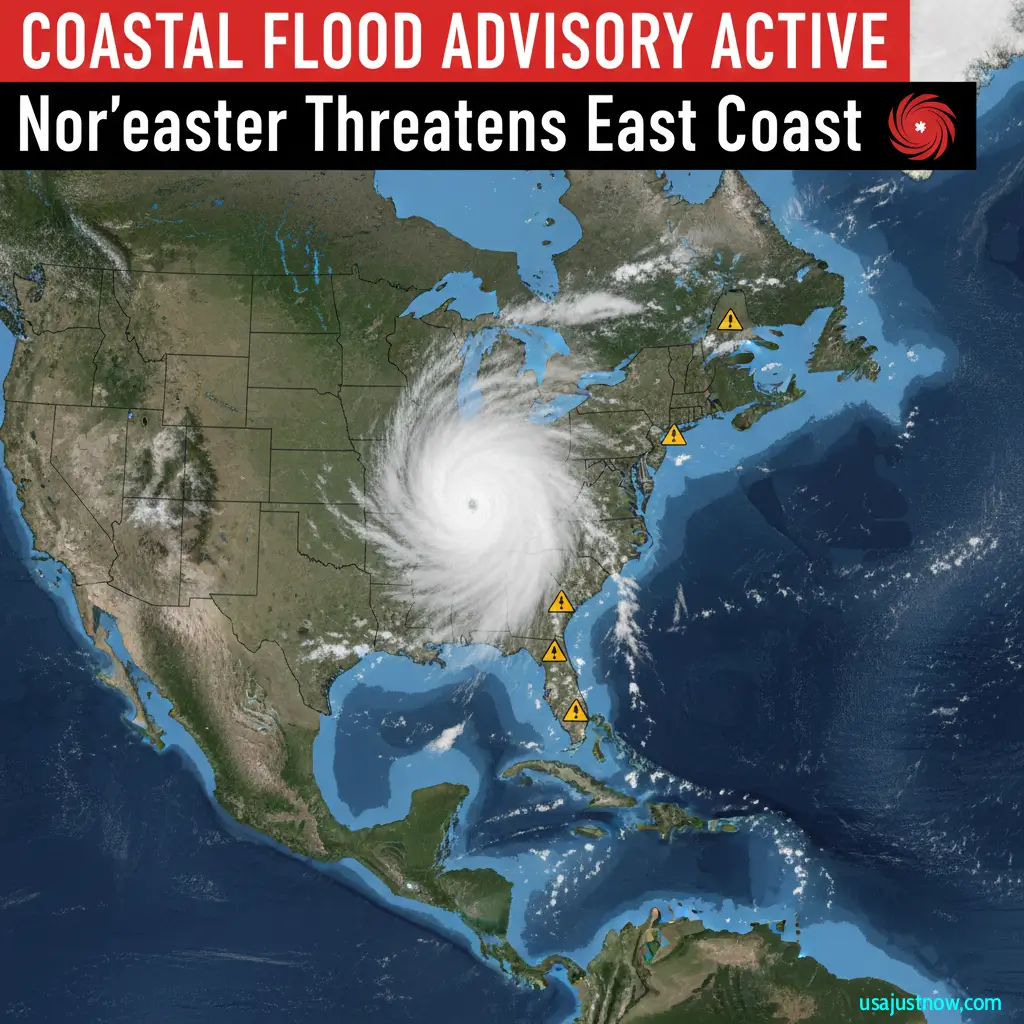Coastal Flood Advisory Active Nor’easter – (Representation)
Atlantic City, NJ – The U.S. East Coast is currently grappling with a potent nor’easter, prompting widespread Coastal Flood Advisories and Warnings that extend from the Mid-Atlantic up through New England. Residents in low-lying coastal communities are urged to remain highly vigilant as this slow-moving storm combines persistent onshore winds with astronomically high tides, creating a significant and prolonged threat of tidal flooding and hazardous marine conditions.
The National Weather Service (NWS) has detailed that the impacts of this system will be felt across multiple high-tide cycles, particularly from Wednesday, October 30th, through Thursday, October 31st, exacerbating the risk of inundation.
What’s at Risk: Local Impacts and Hazards
Road Closures & Property Flooding: Expect water overtopping coastal roads, which could render them impassable, and potentially impact basements and first floors of shoreline properties. In parts of Delaware, forecasts indicate not just high winds and heavy rain, but also significant coastal flooding that could make roadways impassable. New Jersey communities are also preparing for road closures and property inundation across at least three counties. For tips on disaster readiness, see Flood Safety Resources.
Marine Dangers: Gale-force winds and long-period swells are creating dangerous conditions at sea. High surf, strong rip currents, and hazardous boating conditions are prevalent, making water activities extremely unsafe for boaters and swimmers alike.
Critical Locations: Specific areas under heightened alert include Alexandria and Arlington, Virginia, where minor tidal flooding is anticipated to affect streets and properties adjacent to the Potomac River. New York and its surrounding regions, including Long Island, are bracing for significant inundation as the storm’s sustained winds interact with high tides.
Expert Insights on the Storm’s Dynamics
Meteorologists emphasize that the sustained nature of this nor’easter is a key concern. Unlike faster-moving systems, the prolonged northeast winds “pile up” ocean water against the coast, leading to significantly elevated water levels over multiple high-tide cycles. This increases the cumulative stress on coastal infrastructure and amplifies the risk of property damage.
The NWS Philadelphia/Mount Holly office has issued detailed briefings highlighting the sustained threat of elevated water levels over the next 24-48 hours, underscoring the need for continuous vigilance.
What Residents and Visitors Should Do: Essential Safety Guidance
Authorities are stressing the importance of immediate precautions for everyone in advisory zones:
Flood Safety: Never drive or walk through floodwaters. Even shallow water can hide significant hazards and become extremely dangerous.
Relocate Vehicles: Move vehicles, especially those parked in low-lying areas or near tidal rivers, to higher ground well before high tide peaks.
Heed Local Directives: Monitor and obey all local evacuation orders, road closure alerts, and shelter openings from official municipal and emergency services. Track local alerts via the National Weather Service.
Stay Informed: Continuously check trusted weather sources, such as your local National Weather Service office, and local news outlets for the latest updates. The situation remains dynamic and can change rapidly.
Secure Property: Secure any outdoor furniture, trash cans, or other loose items that could be dislodged by winds or floodwaters.
Fact-Check & Editorial Standards:
This article is based on verified information from multiple reputable sources, including official National Weather Service advisories and established news organizations. All specific claims regarding flood advisories, affected regions, and expected impacts are directly sourced from referenced advisories. No unverified or speculative information has been included. Any statement labeled as “expected,” “anticipated,” or “forecast” is derived from current public advisories and expert meteorological models. The dates mentioned reflect the most current advisories available.
References (Direct URLs):
CNN: Strengthening nor’easter threatens major coastal flooding — https://www.cnn.com/2025/10/11/weather/noreaster-storm-east-coast-flooding-winds-climate
USA Today: Nor’easter slams the East Coast — https://www.usatoday.com/story/news/weather/2025/10/13/noreaster-storm-east-coast/86668684007/
Weather.gov PDF Advisory (Oct 30-31) — https://www.weather.gov/media/phi/current_briefing.pdf
Yahoo News: Coastal flood warnings/advisories — https://www.yahoo.com/news/articles/coastal-flood-warnings-advisories-effect-210733093.html
Hindustan Times: Advisory for Alexandria and Arlington — https://www.hindustantimes.com/world-news/us-news/coastal-flood-advisory-issued-for-alexandria-and-arlington-nws-warns-of-tidal-flooding-101760185676140.html
NJ.com: Advisory active for 3 NJ counties — https://www.nj.com/weather-alerts/2025/10/coastal-flood-advisory-active-for-3-n-j-counties-wednesday-and-thursday.html
WBOC News: Marine Forecast, Coastal Flood Advisory — https://www.wboc.com/weather/marine-forecast-for-october-30-2025/article_98d79dc3-ff50-4a76-95f9-604f4386384a.html
NY Times: New York Braces for Flooding — https://www.nytimes.com/2025/10/13/nyregion/noreaster-storm-forecast-damage.html
ABC News: Nor’easter batters East Coast, coastal flood warnings — https://abcnews.go.com/US/strong-potential-noreaster-develops-east-coast-prepares-stormy/story?id=126425305
Delaware Online: Coastal flooding forecast — https://www.delawareonline.com/story/weather/2025/10/29/delaware-weather-forecast-high-winds-heavy-rain-coastal-flooding-nws/86960897007/








